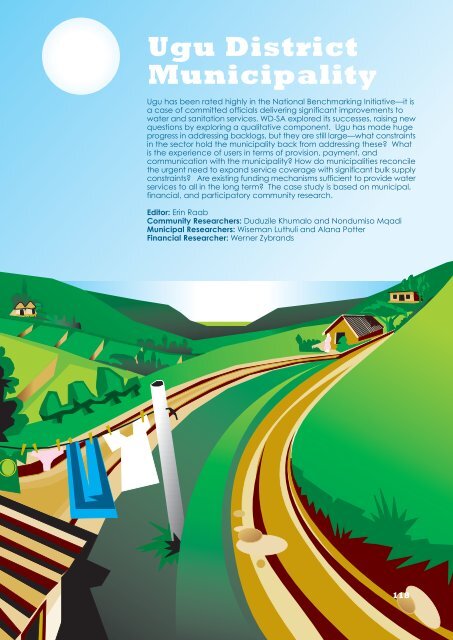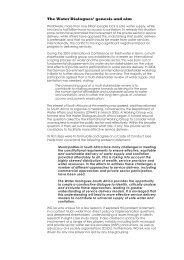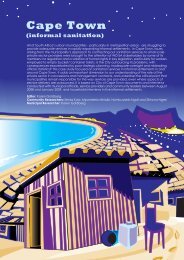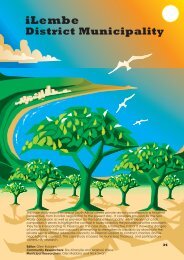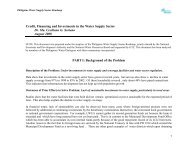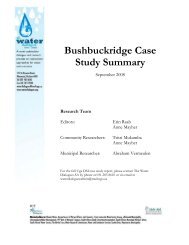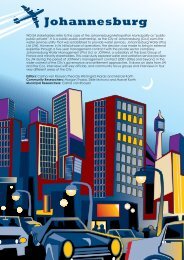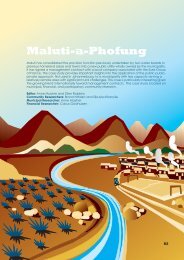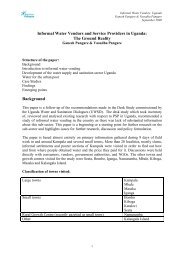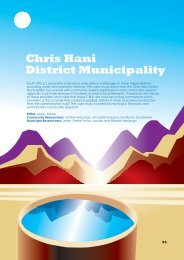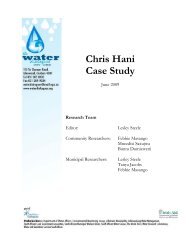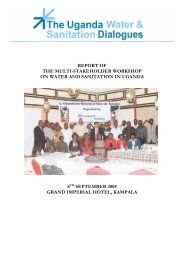Ugu Case Study Summary - The Water Dialogues
Ugu Case Study Summary - The Water Dialogues
Ugu Case Study Summary - The Water Dialogues
Create successful ePaper yourself
Turn your PDF publications into a flip-book with our unique Google optimized e-Paper software.
<strong>Ugu</strong> District<br />
Municipality<br />
<strong>Ugu</strong> has been rated highly in the National Benchmarking Initiative—it is<br />
a case of committed officials delivering significant improvements to<br />
water and sanitation services. WD-SA explored its successes, raising new<br />
questions by exploring a qualitative component. <strong>Ugu</strong> has made huge<br />
progress in addressing backlogs, but they are still large—what constraints<br />
in the sector hold the municipality back from addressing these? What<br />
is the experience of users in terms of provision, payment, and<br />
communication with the municipality? How do municipalities reconcile<br />
the urgent need to expand service coverage with significant bulk supply<br />
constraints? Are existing funding mechanisms sufficient to provide water<br />
services to all in the long term? <strong>The</strong> case study is based on municipal,<br />
financial, and participatory community research.<br />
Editor: Erin Raab<br />
Community Researchers: Duduzile Khumalo and Nondumiso Mqadi<br />
Municipal Researchers: Wiseman Luthuli and Alana Potter<br />
Financial Researcher: Werner Zybrands<br />
118<br />
121
Context<br />
<strong>Ugu</strong> DM consists of six local municipalities: Umuziwabantu, Ezinqoleni and Vulamehlo are located<br />
inland, and Umzumbe, Umdoni and Hibiscus Coast on the coast. In terms of physical development,<br />
<strong>Ugu</strong> DM resembles a ‘T’ shape: areas along the coast have well developed infrastructure and<br />
reasonable economic growth, while the large rural areas are characterised by poor infrastructure<br />
and high unemployment levels.<br />
Key demographic information about <strong>Ugu</strong> DM includes:<br />
<strong>Ugu</strong> DM has over 700,000 residents, about 7.5 percent of thepopulation of KwaZulu-Natal;<br />
84 percent of the <strong>Ugu</strong> DM population resides in the rural areas, while the remaining 16<br />
percent are urbanised;<br />
<strong>The</strong> population is largely low-income. More than 44 percent of households earn less than<br />
R1,500 per month and almost 60 percent earn less than R2,500 per month. <strong>The</strong> unemployment<br />
rate for the district as a whole is estimated at 30 percent; and<br />
Urban areas tend to be wealthier and have access to better infrastructure, more economic<br />
opportunities and a greater range of municipal services than rural areas. Rural households<br />
depend largely on external income sources, e.g. government grants and remittances<br />
from relatives working in urban areas. <strong>The</strong> Hibiscus Coast, with the two largest towns, has<br />
over 30 percent of the population and 60 percent of the economic activity.<br />
1<br />
Participating communities<br />
Communities were chosen with the aim of achieving an accurate representation of the different<br />
types of communities’ diverse experiences, and researchers worked closely with the ward<br />
councillors and other community officials to identify appropriate areas. Participatory community<br />
workshops were held in four distinct areas and participants conveyed information pertaining<br />
to the access, level, quality and affordability of services that are currently being provided.<br />
Researchers also recorded participants’ knowledge of the FBW policy and the relationship the<br />
DM has with communities. Table 1 gives a summary of key information about the communities.<br />
119
Table : <strong>Summary</strong> of community contextual information<br />
Umkhunya<br />
(iLembe)<br />
Amahlongwa<br />
Umthimude<br />
KwaQwabe<br />
Local Municipality<br />
Vulamehlo<br />
Umdoni<br />
Ezinqoleni/<br />
Izingolweni<br />
Umzumbe<br />
Location<br />
Inland, “deep rural”,<br />
northernmost LM of<br />
<strong>Ugu</strong>.<br />
Coastal LM, also some<br />
inland areas. <strong>The</strong> most<br />
developed of the four<br />
communities. Has a<br />
higher population<br />
density and has more<br />
affluent households.<br />
Amahlongwa contains<br />
both peri-urban and<br />
rural areas.<br />
Inland, southern part<br />
of <strong>Ugu</strong>. One of the<br />
largest wards in the<br />
LM.<br />
Rural community in<br />
central <strong>Ugu</strong>, about 40<br />
km outside of Port<br />
Shepstone. Inland,<br />
with a small section<br />
bordering the coast.<br />
Development history<br />
1987 – Major flooding<br />
caused numerous<br />
community deaths.<br />
1986/87 – LIMA (a<br />
NGO) installed<br />
standpipes in the area.<br />
No development<br />
history information<br />
was available.<br />
1992/93 – Political<br />
violence resulted in<br />
many deaths.<br />
1999 – A gravel road<br />
was constructed to<br />
Ntshaseni.<br />
1989 – Electricity<br />
infrastructure reached<br />
community.<br />
1996 – Electricity<br />
infrastructure<br />
installed.<br />
2002–21 – Municipal<br />
toilets were built.<br />
2005 – <strong>Water</strong><br />
infrastructure<br />
(communal standpipes)<br />
was extended to<br />
community.<br />
1996 – Beginning of<br />
the “Development<br />
Councillors”: 13 gravel<br />
roads were constructed<br />
in the area.<br />
2001 – Road access<br />
built.<br />
2007 – Received<br />
“Red Cross” toilets<br />
and standpipe<br />
infrastructure in<br />
some sections.<br />
Overview of water<br />
services<br />
Main source: river<br />
Main source:<br />
standpipes and yard<br />
taps<br />
Main source:<br />
standpipes, boreholes<br />
and streams<br />
Main source: river,<br />
boreholes and<br />
springs<br />
Some households have<br />
access to standpipes, but<br />
the standpipes are often<br />
farther than 200m away.<br />
Even if a household is<br />
close to the standpipes,<br />
members draw water<br />
from the river because<br />
the water pipes break<br />
frequently, leaving the<br />
community without<br />
potable water in the<br />
communal taps.<br />
<strong>The</strong> community<br />
estimates half still gets<br />
water in the standpipes,<br />
while the other half<br />
have managed to<br />
connect to their yards.<br />
Some households get<br />
water from the<br />
standpipes, others<br />
from boreholes and<br />
streams due to either<br />
a lack of standpipe<br />
infrastructure or the<br />
standpipes being<br />
located too far from<br />
the residence.<br />
Most (60 percent)<br />
households get water<br />
from the river,<br />
followed by<br />
boreholes and<br />
springs.<br />
One part of the<br />
community has a few<br />
standpipes (five). In<br />
one section residents<br />
have connected a<br />
pipe to a water main<br />
from an adjacent<br />
urban area to bring<br />
water to their yards.<br />
Free basic water<br />
This community does<br />
not pay for water;<br />
households access water<br />
from rivers. <strong>The</strong>re was<br />
little to no knowledge<br />
of the FBW policy.<br />
Community members<br />
did not seem to<br />
understand FBW and<br />
the benefits of the<br />
policy were unclear to<br />
them.<br />
Standpipe users did<br />
not know about FBW<br />
(they do not pay for<br />
water).<br />
<strong>The</strong> few private<br />
connections pay R26<br />
per month, regardless<br />
of usage. Bills do not<br />
reflect FBW<br />
allowance.<br />
This community<br />
does not pay for<br />
water since<br />
households draw<br />
water mainly from<br />
rivers, boreholes and<br />
springs. <strong>The</strong>re was<br />
little to no<br />
knowledge of the<br />
policy of FBW.<br />
THE WATER DIALOGUES SYNTHESIS REPORT 2009-<strong>Ugu</strong> <strong>Case</strong> <strong>Study</strong><br />
120
Umkhunya Amahlongwa Umthimude KwaQwabe<br />
(iLembe)<br />
Sanitation<br />
services<br />
Main source: self-built<br />
toilets<br />
Main source:<br />
municipal and self-built<br />
toilets<br />
Main source: municipal<br />
toilets<br />
Main source: municipal<br />
toilets<br />
<strong>The</strong> community used<br />
self-built toilets<br />
exclusively until 2002<br />
when the municipality<br />
announced it would build<br />
40 zinc toilets. Only 21<br />
were built, so much of<br />
the community still uses<br />
their old self-built toilets.<br />
While much of the<br />
community has<br />
municipal toilets, some<br />
households were not<br />
able to afford the<br />
installation costs<br />
(households had to pay<br />
for the blocks, dig their<br />
own hole and collect the<br />
municipal-supplied<br />
container from the<br />
councillor).<br />
<strong>The</strong> municipality built<br />
three types of toilets in<br />
the community. One<br />
with concrete walls,<br />
corrugated iron roof<br />
and wooden or<br />
corrugated iron doors,<br />
one that is concrete, and<br />
one that is made of<br />
corrugated iron. Some<br />
households still use<br />
self-built toilets.<br />
All households have<br />
sanitation facilities, and<br />
many have more than<br />
one toilet. <strong>The</strong><br />
households with<br />
multiple toilets refer to<br />
the different kinds as<br />
“<strong>Ugu</strong> toilet”, “Red<br />
Cross toilet”, or “selfbuilt<br />
toilet”.<br />
Overview of findings<br />
This report examines the approach <strong>Ugu</strong> DM has taken toward the delivery of water and sanitation<br />
services. It looks at how serving as both a water service authority (WSA) and water service<br />
provider (WSP) affects its strategy and performance. <strong>The</strong> overall findings show that, overall, <strong>Ugu</strong><br />
is a well-established DM that is making progress on most indicators measured by outside<br />
institutions. However, the district has significant water service delivery challenges, both in terms<br />
of water resource management in a water-scarce area and inherited rural backlogs.<br />
Finding 1: From an official perspective, <strong>Ugu</strong> is performing very well<br />
relative to other district municipalities.<br />
National performance ratings of the <strong>Ugu</strong> DM are high. SALGA’s National Benchmarking Initiative<br />
rates the performance of metros, district municipalities and local municipalities, as <strong>Water</strong> Services<br />
Authorities. <strong>Ugu</strong> DM was one of highest scoring participating district municipalities overall, and<br />
also had a high data confidence rating due to the positive correlations between the information<br />
2<br />
it submitted. <strong>The</strong> report found <strong>Ugu</strong> to have:<br />
<strong>The</strong> highest rate of payment collection (between 90 and 100 percent);<br />
An impressive rate of eliminating backlogs (between six and ten percent annually):<br />
Between 2001 and 2005, <strong>Ugu</strong> reduced backlogs in water services by 24 percent, an<br />
3<br />
average annual rate of six percent. <strong>The</strong> current rate of reduction has increased to<br />
4<br />
around 10 percent per year;<br />
Backlogs in sanitation services were reduced by four percent, an average annual<br />
5<br />
rate of one percent, much lower than the reduction in water services backlogs; and<br />
<strong>The</strong> lowest proportion of water quality sample failures (less than five percent).<br />
Three of the four communities involved in the research have had standpipes installed within the<br />
past six years and two have received access within the last three years. This indicates that there<br />
has been a significant increase in the extension of infrastructure to previously unserved areas.<br />
<strong>The</strong> low failure rate of water quality samples suggests that, when residents have access, water<br />
is safe to consume.<br />
121<br />
THE WATER DIALOGUES SYNTHESIS REPORT 2009-<strong>Ugu</strong> <strong>Case</strong> <strong>Study</strong>
Finding 2: <strong>The</strong>re are still massive backlogs, though they are not spread<br />
evenly across the district municipalities: urban coastal areas receive<br />
better services than inland rural communities.<br />
<strong>The</strong> municipality is performing well, relative to other district municipalities, but substantial<br />
investments are required to provide effective, equitable and affordable water and sanitation.<br />
While <strong>Ugu</strong> is making progress in the inland areas, the backlogs are still considerable and the<br />
difference in level of services between urban and rural areas is quite marked:<br />
Around 40 percent of the population still does not have access to potable water, which<br />
means about 263,000 <strong>Ugu</strong> residents are living without access to safe water:<br />
99.4 percent of urban residents and 35 percent of rural households have access to<br />
water at a Reconstruction and Development Programme (RDP) standard of a<br />
standpipe within 200 metres;<br />
Informal settlements outside of established urban areas are not counted in the 16<br />
percent of residents who reside in urban areas. Residents in these areas make up<br />
about two percent of the population and are mostly served by standpipes, and<br />
some from natural sources; and<br />
In the communities where the research was conducted, most residents obtained<br />
their water from standpipes or rivers. <strong>The</strong> majority of people in the four communities<br />
do not have metered connections or pay for their water.<br />
Delivery of sanitation services parallels that of water in terms of the urban/rural divide, but<br />
both the number of backlogs and the difference between levels of service are greater:<br />
70 percent of the population does not have access to basic sanitation;<br />
6<br />
Around 14 percent of households have waterborne sewage systems. <strong>The</strong>se are<br />
almost exclusively in urban areas. <strong>The</strong> access and level of sanitation services in rural<br />
areas are still very low, but some communities have begun to receive Ventilated<br />
Improved Pit latrines (VIPs);<br />
All of the research communities had some form of municipal sanitation, but the<br />
quantity and quality was often inadequate, and a number of households in all of<br />
the areas were still using toilets they had constructed themselves.<br />
Finding 3: <strong>Ugu</strong> struggles to secure adequate funding to eradicate<br />
backlogs in water and sanitation provision, despite being fairly highly<br />
capacitated and applying for grants.<br />
<strong>Ugu</strong> DM is a large, well-established municipality, with a good-sized operating expenditure (OPEX)<br />
budget, but the municipality contends the main reason for the remaining backlogs in both<br />
urban and rural areas is insufficient funding to effectively address the backlogs:<br />
<strong>The</strong> estimated cost of eradicating water backlogs is R1.12 billion. <strong>The</strong> cost could potentially<br />
be higher due to lack of readily available natural sources of water, and areas with low<br />
7<br />
population densities or dispersed settlement patterns.<br />
<strong>The</strong> backlogs in sanitation are even greater. <strong>The</strong> estimated cost of providing a VIP for each<br />
family across <strong>Ugu</strong> DM is estimated to be R280 million. In high-density urban areas, improvement<br />
8<br />
of water-borne sewerage comes at an even greater per-capita cost.<br />
Officials estimate that <strong>Ugu</strong> has sufficient staff capacity to efficiently spend about double the<br />
amount of funds it has currently been allocated, which they predict would greatly accelerate<br />
the expansion of basic services coverage<br />
Finding 4: From most official reports, it appears that <strong>Ugu</strong>’s financial<br />
management is sound.<br />
SALGA’s National Benchmarking Initiative Report, 2007 shows the following:<br />
Cash collection efficiency is between 90 and 100 percent, and water services provider<br />
9<br />
billing is 99.9 percent accurate. Internal accounting techniques appear to play a role in<br />
the high payment rates. Despite the unrestricted access communities have to water from<br />
standpipes, the accounting department considers the municipality to be “billing everyone”.<br />
THE WATER DIALOGUES SYNTHESIS REPORT 2009-<strong>Ugu</strong> <strong>Case</strong> <strong>Study</strong><br />
122
For areas where there is only free basic water (FBW), the accounting department still creates<br />
an invoice and it is “billed” to the municipality’s Equitable Share allocation.<br />
Meter coverage grew from 45 percent in 2005 to 95 percent in 2006. <strong>Ugu</strong> has the highest<br />
revenue per connection (over R100/month) of the 15 participating DMs. Where residents<br />
have metered water connections or secure municipal sanitation facilities (including VIPs),<br />
the cost of connections, basic monthly charges and maintenance are high compared to<br />
other municipalities, and community workshop participants felt they were too high to be<br />
affordable for their households.<br />
However, <strong>Ugu</strong> DM’s budgeting and debt treatment raises some issues:<br />
Actual expenditure at 31 December 2007 was only about seven percent of the original<br />
budget. Much of this discrepancy is attributed to loans which have been late in getting<br />
approved, or because <strong>Ugu</strong> is still searching for new sources of funds. When asked about<br />
this under-spending, a municipal official explained that the original budgets were designed<br />
to include all of the loans and financing the municipality was hoping to receive.<br />
Despite a very high payment rate, <strong>Ugu</strong> DM carries a considerable amount of debt, about<br />
54 percent of which can be considered irrecoverable and which may hamper the<br />
municipality’s ability to secure additional loans.<br />
Unaccounted for water was at 35 percent in 2006, which some consider high. According<br />
to a municipal official, the debt is almost totally from households/individual accounts, and<br />
a large amount of the debt was inherited from the townships and community-based<br />
organisations when they were absorbed. <strong>The</strong> fact that all of the inherited debt is more than<br />
90 days old goes some way towards explaining the bad debt. Still, debt continues to accrue;<br />
one could figure that if there is a 96 percent payment rate, then the debt accumulation<br />
should be around four percent per annum, yet it is still a significant amount.<br />
<strong>The</strong>re does appear to be a concerted effort to stabilise the outstanding debtor situation. A<br />
municipal official told researchers there are different mechanisms being used to recover this<br />
debt. One is a recovery programme, through which users make an agreement to pay debt<br />
over a period of time. One household with an income of two pension grants reported having<br />
been part of this debt recovery programme. <strong>The</strong>ir experience suggests the municipality is<br />
implementing the debt-collection programmes mentioned by officials, but also that charges<br />
may be too high for poor households and they may have to sacrifice other essentials to be<br />
able to pay for water.<br />
Finding 5: <strong>Water</strong> is expensive, relative to other South African<br />
district municipalities, for residents who pay for access.<br />
<strong>The</strong> majority of people do not pay for their water because they access it through standpipes;<br />
however, where connections are metered, the tariffs are high. <strong>The</strong> few households with metered<br />
connections in the selected communities (generally located in urban or peri-urban areas,<br />
though there are a few rural residences with household connections) find services to be<br />
expensive, and participants were sceptical they receive the FBW allocation. While urban areas<br />
tend to have higher levels of sanitation services than rural areas, this benefit is often not affordable<br />
for the urban poor.<br />
Urban users were more likely to find water services unaffordable and more likely to end up<br />
with their connections cut off or restricted due to non-payment. In the most developed<br />
areas, some community members did not have municipality-built toilets because they could<br />
not afford the cost of installation;<br />
Any household with a basic connection pays a basic charge ranging from R19.37 to R77.43.<br />
In addition to the basic connection charge, the charges for consumption start at R6.06 per<br />
10<br />
kilolitre, which is unusually high compared to other district municipalities nationally. <strong>The</strong>se<br />
are relatively high charges compared to other municipalities participating in SALGA’s<br />
National Benchmarking Initiative;<br />
123<br />
THE WATER DIALOGUES SYNTHESIS REPORT 2009-<strong>Ugu</strong> <strong>Case</strong> <strong>Study</strong>
Furthermore, community members pay for the building blocks, dig their own holes and,<br />
although the municipality provided the container, households have to collect the container<br />
from the councillor which requires a vehicle. This further increases the overall cost of<br />
installing toilets.<br />
Rural users with access to standpipes are not prevented from accessing an unlimited amount<br />
of water in theory, but the access is at a lower level of service (e.g. standpipes). It is also unlikely<br />
a household would be able to access more than six kilolitres per month as it would be almost<br />
impossible to carry that amount of water over that time period, and access is also restricted<br />
by frequent disruptions in the service due to pipes breaking or low water pressure.<br />
Finding 6: <strong>Ugu</strong> DM has a FBW policy, but there is some confusion about<br />
how many people it covers, how it is reflected in billing and whether it<br />
is well-publicised.<br />
<strong>Ugu</strong> DM maintains it allows every household six kilolitres of water per month under the FBW<br />
policy. However, the statistics on users receiving FBW, as with the backlog and other data, are<br />
inconsistent across different organisations’ studies and reports.<br />
<strong>Ugu</strong> DM reports 61 percent of the population is receiving FBW (everyone with access), but the<br />
2006/07 Provincial <strong>Water</strong> Sector Plan reports that <strong>Ugu</strong> is only reaching 41.6 percent of the total<br />
population with FBW and only 46.6 percent of the poor population. According to the Provincial<br />
<strong>Water</strong> Sector Plan, this is one of the lowest percentages of all of the district municipalities in the<br />
province.<br />
Part of the confusion may be about what is considered provision of “free” basic water.<br />
While water from communal standpipes is free, any household with a connection pays a<br />
basic charge;<br />
Tariff policies accessed via the DM’s webpage do not clearly reflect how the policies apply<br />
(especially the indigent policy).<br />
Typically, the charges per kilolitre should only commence after the FBW allocation of six kilolitres<br />
has been used. <strong>Ugu</strong> implements a FBW policy and has an official indigent register for metered<br />
users, but none of the communities had much knowledge about either.<br />
In KwaQwabe and Umkhunya no one was paying for water as the highest level of service<br />
available was standpipes, thus participants did not know about the policy, and were<br />
understandably not very concerned about it. In Umthimude and Amahlongwa, where some<br />
households were receiving bills, participants still indicated they had very little knowledge about<br />
FBW. <strong>The</strong>re was, however, some indication from the communities that the FBW policy was being<br />
applied. In one area, elderly people were charged reduced connection fees by the municipality.<br />
One of the participants, who is disabled, said he does not pay for water and he took this upon<br />
himself to let the municipality know about his disability. He said he had been telling other people<br />
in the community to do the same.<br />
<strong>The</strong> question remains as to whether the indigent register is well-publicised, whether it shows<br />
clearly on statements or whether the application process is user-friendly, but the policy is in<br />
place to protect the poor. If a user can show the household has an income of less than R2,000<br />
per month, the household is qualified for reductions in some fees:<br />
<strong>The</strong> basic charge for water is waived for usage of up to six kilolitres per month. <strong>Water</strong> usage<br />
above six kilolitres is charged at the standard tariff applicable to other users. If a household<br />
fails to pay for over-usage, a restrictive device is installed to limit water consumption to<br />
the six kilolitres per month until the outstanding amounts are paid;<br />
<strong>The</strong> municipality is piloting a programme for indigent households that waives the monthly<br />
sanitation charge (for those on the indigent register who have water-borne sewage), and<br />
provides households using conservancy tanks with one free draw per month.<br />
Finding 7: Like most South African municipalities, <strong>Ugu</strong> is facing a critical<br />
shortage of staff.<br />
<strong>Ugu</strong> DM has a large staff dedicated to water and sanitation services, and has a relatively good<br />
retention rate. However, it faces severe shortages in key skilled areas and many positions,<br />
THE WATER DIALOGUES SYNTHESIS REPORT 2009-<strong>Ugu</strong> <strong>Case</strong> <strong>Study</strong><br />
124
particularly in middle and upper management, are left unfilled for significant periods, thus<br />
detracting from <strong>Ugu</strong> DM’s ability to accomplish its plans. <strong>The</strong> past few years have seen a decline<br />
in overall numbers of staff, especially technically qualified, skilled staff. According to municipal<br />
officials, <strong>Ugu</strong> has been successful largely due to individuals who have stayed with the municipality<br />
over long periods of time and are extraordinarily committed to their jobs. However, <strong>Ugu</strong> has a<br />
hard time recruiting new, experienced and committed management staff.<br />
Finding 8: <strong>The</strong>re is a little separation between the water services<br />
authority and WSP functions of the municipality, with potential<br />
implications for regulation.<br />
Weak national regulation means the municipality acting as a water services authority is moreor-less<br />
regulating itself as a WSP, which would make weak separation between the two functions<br />
a concern. Staff movement between the two sections seems to happen frequently in both<br />
directions, which might suggest the two are not as separate as would be ideal. A new plan of<br />
having the <strong>Water</strong> Services Authority and <strong>Water</strong> Services Provider Managers both reporting to<br />
the General Manager of water services may compromise the WSA’s autonomy and affect the<br />
regulation of water service provision. It may also increase the potential for the development<br />
of undesired incentives in terms of oversight and reporting. Of course, the municipality will have<br />
to continue to account for the functions separately when reporting to the Province and grant<br />
donors. <strong>The</strong>se concerns may be addressed when the organisational plans are finalised.<br />
Furthermore, in this case, the relatively good performance may raise broader questions about<br />
the need for such a division.<br />
Finding 9: <strong>Ugu</strong> DM has a long history of being proactive in providing<br />
services, and is ahead of many municipalities in terms of creating plans<br />
for the extension of services.<br />
In 2006, <strong>Ugu</strong> DM created a master plan for bulk water services. <strong>The</strong> plan outlines a mediumterm<br />
vision of where and in what order extensions of bulk supply will take place. It also addresses<br />
key concerns, such as ways to prepare for the dry months in communities that suffer from<br />
periodic drought.<br />
According to municipal officials, the initial motivation for the bulk plan was that there was a<br />
drive to increase reticulation between 2001 and 2004. This allowed <strong>Ugu</strong> to eliminate backlogs<br />
at a comparatively rapid pace, but not enough attention was paid to the expansion of the<br />
11<br />
bulk supply to match increased demand in the longer term. Since <strong>Ugu</strong> will need to extend<br />
the bulk networks for reticulation in order to address water needs, this may mean a temporary<br />
reduction in the current pace of connections.<br />
Bulk networks are necessary, but not sufficient, to increase access for users on the ground:<br />
reticulation infrastructure is also needed. As <strong>Ugu</strong> moves from planning to implementation of<br />
the bulk master plan, management is moving on to the creation of a reticulation master plan.<br />
A reticulation plan is important in terms of assessing the equitability of extension plans.<br />
Finding 10: Insufficient funds are allocated to operations and<br />
maintenance to ensure proper upkeep of current infrastructure.<br />
<strong>The</strong> costs of operations and maintenance do not seem to be adequately addressed, and this<br />
is one area where municipal officials’ and community members’ concerns were directly aligned.<br />
Workshop participants across all of the communities noted that the poor condition/quality of<br />
the pipes was causing frequent breakages or bursts, leaving the people without access to<br />
water for extended periods of time. <strong>Water</strong> supply was at times cut off without any advance<br />
notification that might allow for households to prepare, meaning they were forced to use river<br />
water if water supply was cut at the standpipes. Municipal officials are aware of the issues, yet<br />
find it difficult to give them the necessary attention due to inadequate funds and insufficient<br />
staff to properly perform all necessary operations and maintenance procedures.<br />
125<br />
THE WATER DIALOGUES SYNTHESIS REPORT 2009-<strong>Ugu</strong> <strong>Case</strong> <strong>Study</strong>
<strong>The</strong> lack of focus on operations and maintenance has serious implications for the long-term<br />
sustainability of water systems. While there is an official register of assets, the asset management<br />
strategy is almost totally reactive. An asset management plan is reportedly in progress to seek<br />
to correct this problem.<br />
Additional funds will be needed for <strong>Ugu</strong> to be able to maintain new infrastructure at acceptable<br />
levels of services, particularly because the conditions of the municipal infrastructure grant<br />
expressly stipulate that it cannot be used for operations and maintenance.<br />
Finding 11: <strong>Ugu</strong> could improve its efficiency and the maintenance of its<br />
infrastructure through improved customer service and communication.<br />
<strong>Ugu</strong> DM has recently made changes to the organisational structure to promote better<br />
communication using different methods, including:<br />
An official DM website (http://www.ugu.org.za) has been set up with extensive information<br />
about policies, rates, tariffs, Integrated Development Plans and contact details;<br />
Project steering committees meet monthly in each community. <strong>The</strong> committees are made<br />
up of local residents and are primarily used for the identification of labour and pipe routes,<br />
and to inform residents of the indigent policy;<br />
Permanent Institutional and Social Development Officers are responsible for two local<br />
municipalities each. <strong>The</strong>se officers are in charge of raising awareness regarding water<br />
conservation and demand management. <strong>The</strong> officers also keep in touch with municipal<br />
councillors and traditional leaders about local water issues, and seek to circulate water<br />
trucks when service fails;<br />
Road shows: <strong>Ugu</strong> interacts with communities through mayoral road shows which are<br />
conducted at the end of the year. <strong>The</strong>se publicise the budget and plans of the municipality<br />
although not specifically for water and sanitation;<br />
Local media is used for communication of specific information or policies, such as the<br />
indigent policy. <strong>Ugu</strong> will take out newspaper advertisements, have radio interviews on<br />
Radio Sunny South, distribute posters or flyers with the information and/or send staff to do<br />
ad-hoc community visits to speak directly with users;<br />
<strong>The</strong>re is a user call centre where users can make inquiries or report complaints.<br />
Despite these efforts, users had very little knowledge of free basic services or municipal policies<br />
regarding water usage and extension of infrastructure, i.e. the fact that problems were being<br />
addressed. In particular there appears to be some ambiguity about the tariff system and<br />
affordability of water in <strong>Ugu</strong>, and about the municipality’s application of the FBW policy.<br />
In only one community did participants mention that some residents phone <strong>Ugu</strong> directly and<br />
few users had knowledge of the customer care call centre. Problems such as burst pipes or<br />
water cut offs, were generally reported to the local councillor or ward committee, which was<br />
not always effective.<br />
Two of the communities have a small local <strong>Ugu</strong> office where they can report problems and, in<br />
one area, they are supposed to pick up bills from this office if they have a metered connection<br />
(although a staff member reported that most people do not collect their bills).<br />
A few participants from different communities mentioned being nervous about going into <strong>Ugu</strong><br />
offices because they were afraid they would be treated poorly. It is unclear whether this is due<br />
to poor treatment previously experienced by members of the community, or is an unfounded<br />
fear.<br />
Finding 12: <strong>Ugu</strong> DM found the use of community-based organisations<br />
problematic and decided not to use them for delivery in the long term.<br />
From 1994 until 2000 DWAF was responsible for water and sanitation service provision. DWAF<br />
adopted a community-based delivery approach to implementing water services in rural areas,<br />
working in collaboration with local and national NGOs. In <strong>Ugu</strong> alone, around 17 different<br />
community-based water projects were formed, with mandates to operate and manage water<br />
supply in the district.<br />
THE WATER DIALOGUES SYNTHESIS REPORT 2009-<strong>Ugu</strong> <strong>Case</strong> <strong>Study</strong><br />
126
<strong>Ugu</strong> DM was formed in 2000 and, for the first time, it included both urban coastal and rural<br />
hinterland areas. <strong>The</strong> period between 2000 and 2003 was marked by uncertainty about which<br />
level of local government would ultimately be responsible for providing water and sanitation<br />
services. According to interviewees, though it was not certain that the DM would be given the<br />
water services authority or the WSP functions, management decided to act as though it would<br />
be. Consequently, while DWAF was collaborating with and creating CBOs in the rural areas, <strong>Ugu</strong><br />
was building capacity and knowledge by focusing its attention on extending and improving water<br />
and sanitation throughout the urban coastal areas for which it had official responsibility.<br />
When the division of powers and functions was gazetted in July 2003, <strong>Ugu</strong> DM was indeed<br />
delegated the WSA function, meaning it would also need to determine how the WSP function<br />
would be fulfilled. <strong>The</strong> changing legislative environment, including the introduction of the FBW<br />
policy in 2000, required <strong>Ugu</strong> DM to reconsider the use of the CBO model for delivery of water and<br />
sanitation services when they took over the WSA function in 2002-2003. In the end, the municipality<br />
chose to disband the CBOs, absorb most of the employees, and develop an internal model to<br />
deliver water and sanitation services. Municipal officials reported that the CBOs were disbanded<br />
because: management (both general and financial) tended to be poor; they were costly to the<br />
municipality in terms of technical support and major maintenance (fixing breakages, installing<br />
taps, etc.); they were, with a few important exceptions, running at a loss each year and had often<br />
racked up a considerable debt; and, finally, with the announcement of the FBW policy in 2000,<br />
the structure of the CBOs would have to be dramatically changed for even the well-managed<br />
ones to remain financially viable.<br />
This decision attracted a significant amount of criticism from advocates of community-based<br />
services. <strong>The</strong>y argued that CBOs provided a local source of employment and community<br />
development and that a few were successful enough to be able to raise sufficient capital to<br />
make micro-loans to community members. Furthermore, the municipal system did not necessarily<br />
minimise opportunities to use positions for personal gain through politics or corruption, because<br />
the majority of the CBOs’ staff were absorbed into the new system. Most of the workshop participants<br />
could not identify when the transfer took place, since the person running the day-to-day water<br />
service provision in their communities did not change.<br />
<strong>The</strong> initial WD-SA research plan proposed to compare the water and sanitation services delivery<br />
by CBOs and by <strong>Ugu</strong> DM. However, the data researchers were able to gather did not allow for<br />
a comparative analysis as there was very little information about services delivery under CBOs.<br />
Thus, no conclusive findings could be drawn from a comparison of the two. However, it is hoped<br />
that other municipalities using CBOs and WSPs, such as the Chris Hani DM, might provide more<br />
insight into the benefits and challenges of the model. It may be worthwhile for <strong>Ugu</strong> DM to revisit<br />
the model to see if it is worth re-integrating parts of the design.<br />
Finding 13: <strong>The</strong> sustainability and equitability of the current water and<br />
sanitation system are related. While it might be financially viable and<br />
people are surviving, from the point of view of the community, the status<br />
quo is not sustainable.<br />
<strong>The</strong> challenges facing <strong>Ugu</strong> DM are considerable, though not necessarily unique within the South<br />
African context. <strong>Ugu</strong> has made impressive progress in less than a decade of managing water<br />
and sanitation services for the region. <strong>The</strong> successes and strengths <strong>Ugu</strong> DM has shown thus far,<br />
particularly in planning and eradication of backlogs, and the ways in which it handles challenges,<br />
both under and outside of its control, could inform national policy reform and other municipalities’<br />
plans and institutional arrangements.<br />
Despite this, few of the participants seemed completely satisfied with the level of service they are<br />
receiving, they either desired a higher level (standpipe users want yard pipes, etc.) or they<br />
expressed frustration about the water pressure or continuity of supply. More importantly, not<br />
everyone has access even to basic services, leaving them greatly disadvantaged in terms of their<br />
ability to pursue opportunities for advancement.<br />
Thus, while <strong>Ugu</strong> DM has made impressive progress in less than a decade of managing water and<br />
sanitation services for the region, equitability in <strong>Ugu</strong>, as in the rest of South Africa, is a problem<br />
requiring long-term plans and goals: It has its roots in decades of forced denial of services to the<br />
majority of the population and will not be eradicated overnight. <strong>Ugu</strong>’s experiences suggest that<br />
there are vital changes that should be considered in current national legislation and funding<br />
policies if the national government is to be fully supportive of local governments’ struggle to<br />
address the continuing challenges in the provision of water and sanitation services for all.<br />
127<br />
THE WATER DIALOGUES SYNTHESIS REPORT 2009-<strong>Ugu</strong> <strong>Case</strong> <strong>Study</strong>


